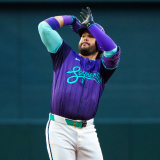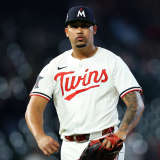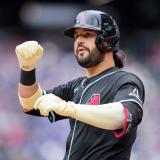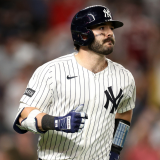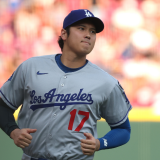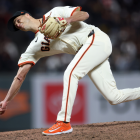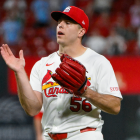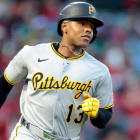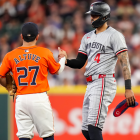
How Bryan Woo became the Mariners' ace -- and one of the best pitchers in baseball
Woo's ERA+ bests standout names like Garrett Crochet, Corbin Burnes and Hunter Brown
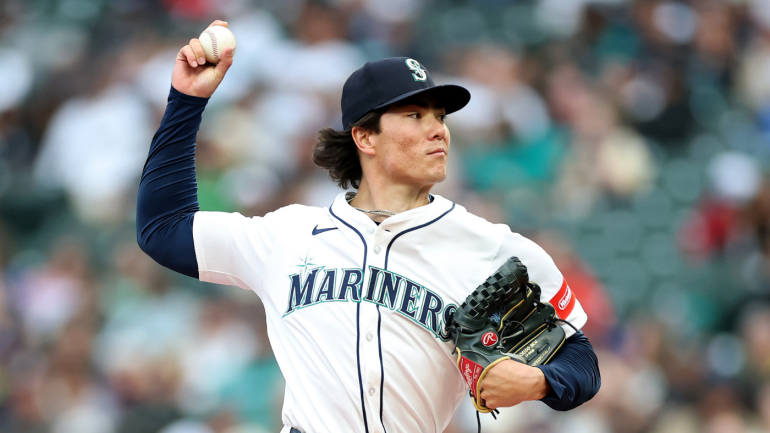
Here's a fun piece of trivia. Coming into Tuesday, the two-month mark of Major League Baseball's regular season, just two starting pitchers have recorded at least 10 appearances thus far in which they worked six or more innings. One of those was Philadelphia Phillies ace Zack Wheeler, who seems all but destined to record yet another high finish in National League Cy Young Award voting. The other pitcher? Bryan Woo, the unlikely ace of the first-place Seattle Mariners.
It's no stretch to describe Woo, 25, as one of the best starters in baseball. Dating back to last Opening Day, he ranks 12th in ERA+ (135) among pitchers with at least 150 innings. That's ahead of Garrett Crochet, Corbin Burnes, Hunter Brown, Spencer Schwellenbach, and hordes of other starters with higher profiles. Woo's 7.67 strikeout-to-walk ratio, meanwhile, is tops among that same pitcher pool -- better even than Seattle teammate George Kirby and force of nature Tarik Skubal. Not bad for someone originally selected with the 174th pick in the 2021 draft.
Who could blame teams for passing? While Woo had shown improved stuff during his platform season at Cal Poly, he had also compiled a 6.11 ERA and injured his elbow. He later required Tommy John surgery that delayed his professional debut until June 2022. Less than a year later, he was logging big-league innings. Woo has since completed his ascension. Again, coming into Tuesday, he leads the Mariners in innings pitched, strikeouts, and strikeout-to-walk ratio. He ranks second in ERA+ on the staff, albeit while recording twice as many frames as the leader, right-hander Logan Gilbert.
Woo, then, has been a pivotal part of Seattle's early success, thanks in large part to two key components of his game.
1. Highly effective fastball
Woo's 95.5 mph heater doesn't come in as hot as, say, Paul Skenes' or Hunter Brown's, but it's achieved the ninth-highest whiff rate among qualified pitchers anyway. How does he do it? At least in part by benefitting from the relationship between his release point and his fastball's innate life.
There's an undeniable relationship between how and where a pitcher releases the ball and the movement of their offerings. That's why it's not enough to look at raw movement data when analyzing individual repertoires. You have to contextualize it based on release point.
Bryan Woo's 2Ks in the 2nd. pic.twitter.com/d3IooSZ6fX
— Rob Friedman (@PitchingNinja) May 24, 2025
To wit, 124 pitchers have to date thrown at least 200 four-seam fastballs. Woo's release height (around 5-foot-1) ranks as the ninth shortest in that group, yet he imparts more than 15 inches of induced vertical break on his fastball. There are only two pitchers within two inches of Woo's release height who generate more carry on their fastballs: Ben Lively and Logan Allen, both members of the Cleveland Guardians. (Lively is out for the season after falling victim to Tommy John surgery.)
The optical illusion created by Woo helps to explain why he's generated a 30.4% whiff rate. It also helps to explain why batters have hit an arsenal-best .197 against the heater for his big-league career. Interestingly, despite Woo gaining velocity this season, he's reduced his fastball's usage rate from 48.1 to 42%, in the process creating space for the rest of his arsenal to fill.
2. Improved platoon splits
While Woo's flat release point (relative to the upper portion of the zone) is a blessing for him and a desirable trait in modern pitching analysis, the reason you used to not see too many starting pitchers with lower arm angles had to do with the corresponding platoon tax. A 2015 study at The Hardball Times found that righty pitchers with arm angles between 20 and 40 degrees (Woo's is 27 degrees) saw their strikeout rate drop more than 3%, their unintentional walk rate increase by more than 2%, and their wOBA increase by 28 points on average when they faced lefty batters.
Woo himself has been a victim to that trade-off in the past. When he first came up, back in 2023, he developed one of the widest platoon splits you'll ever see at the big-league level. Whereas he held right-handed hitters to a .494 OPS, lefties scorched him for a .928 OPS. Woo has since made impressive gains in this respect, and he'll enter his next start with a sub-.600 OPS against lefties.
| Season/split | OPS vs. RHB | OPS vs. LHB | Net (LHB-RHB) |
|---|---|---|---|
2023 | .494 | .928 | .434 |
2024 | .540 | .605 | .065 |
2025 | .544 | .588 | .044 |
The most fascinating part of Woo's improvement against lefties is that it didn't entail a substantive shift in overall pitch mix or location. He's thrown his four-seamer more than 50% of the time against them in each season, and none of his other pitches have deviated more than a few percentage points here and there on a year-to-year basis. Ditto for his location rates.
If you're seeking the proverbial silver bullet that explains why Woo has been more effective without the platoon advantage since 2023, the closest thing might be his pitch usage in two-strike counts. Back in 2023, he was dependent on his four-seamer and his slider in those situations. He's since shifted more of his usage rate towards his sinker and changeup, with those pitches combining for a 17.9% share in 2023 versus a 33.8% share in 2025.
Perhaps Woo has made other alterations that aren't so easily captured by statistics. Whatever the case, he's clearly got a nice formula working for himself -- and for those first-place Mariners.
![[object Object] Logo](https://sportshub.cbsistatic.com/i/2020/04/22/e9ceb731-8b3f-4c60-98fe-090ab66a2997/screen-shot-2020-04-22-at-11-04-56-am.png)





